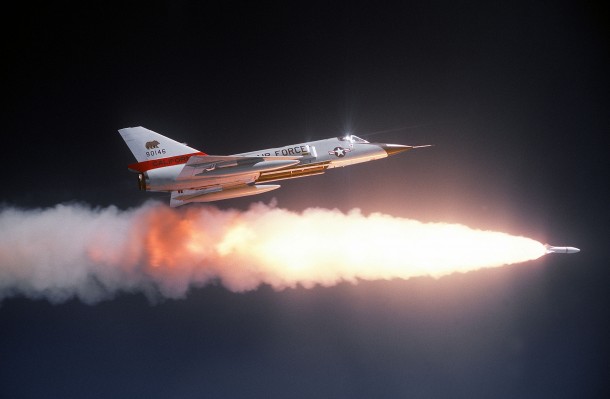
Fifty-seven years ago this month, the United States successfully conducted the only live-fire test of the only known nuclear-armed air-to-air missile ever developed by the West. The test took place in the skies over the Nuclear Test Site located at Yucca Flats, Nevada.
The Cold War between the Soviet Union and the United States gave rise to the development of myriad nuclear weapons. Both superpowers ultimately relied on a triad of platforms, consisting of bombers, missiles and submarines, to deliver nuclear ordnance. Each side used these same types of platforms in a defensive role as well.
The United States employed land-based interceptor aircraft for defending against the Soviet bomber threat. These aircraft would go out to engage and destroy Soviet bomber groups before the latter could penetrate US airspace. The weapon of choice for taking out the bombers was the air-to-air missile.
The most fearsome of air-to-air missiles was armed with a nuclear warhead. The idea was simple. A defending aircraft would fire the nuclear-armed missile into a bevy of Soviet bombers. Detonation of the warhead would in theory destroy an entire bomber group with a single atomic blast.
The Douglas Aircraft Company produced just such a missile for the United States Air Force in the mid-1950′s. The subject missile was originally known as the MB-1 Genie (aka Bird Dog, Ding-Dong, and High Card). The type’s 1.5 kiloton nuclear device had a blast radius on the order of 1,000 feet.
The Genie measured 9.67 feet in length and had a nominal diameter of 17.5 inches. Firing weight was 822 pounds. Genie’s Thiokol SR49-TC-1 solid rocket motor had a rated thrust of 36,500 pounds. The resulting high thrust-to-weight ratio allowed the missile to quickly accelerate to the target. Genie had a top Mach number of 3.3 and a range of slightly over 6 miles.
Genie was carried by the top USAF interceptor aircraft of its day; the Northrop F-89 Scorpion, McDonnell F-101B VooDoo and Convair F-106 Delta Dart. The missile was unguided. That is, Genie was simply a point and shoot weapon. The warhead would detonate only after rocket motor burnout. This delay permitted the carrier aircraft to quickly depart the area following launch.
The only in-flight detonation of a Genie warhead occurred during the summer of 1957 as part of Operation Plumbbob. This program was series of nuclear weapons tests conducted from May to October of the subject year at the Yucca Flats Nuclear Test Site in Nevada.
At 1400 UTC on Friday, 19 July 1957, USAF Captain Eric Hutchison fired a single Genie missile from his Northrop F-89J aircraft. The missile’s W25 warhead detonated at 15,000 feet above ground level shortly after rocket motor burnout. A group of USAF officers was positioned directly below the air burst to prove that the missile could be used over populated areas. The men were reported to be unharmed.
Genie was never fired in anger. Approximately 3,150 missiles were produced by the time Thiokol closed down the production line in 1963. This production run included a number of improved variants known as the MB-1-T, ATR-2A, AIR-2A and AIR-2B. Genie ultimately served with both the USAF and the Canadian Air Force. It was withdrawn from service in 1985.

